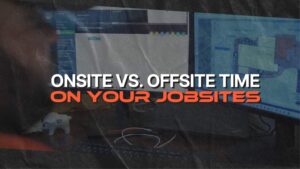How To Calculate Your Hourly Rate

Do you know how to calculate your hourly rate?
I just got back from speaking at Brian Fullerton’s Lawntrepreneur Academy Live event in Novi Michigan, and it was fantastic! 400 green industry business owners in the room, the energy was buzzing.
As I mulled over what to share this week, my mind kept circling what I shared at the event: the right (and wrong) way to calculate your hourly labor rate.
So just how do you calculate your hourly labor rate?
Well, I can tell you how probably most of us started. 😜
We looked around at the other contractors in town, checked out the cheap low baller, looked at the high-end contractor, and were like “Ehhh, I’m not as bad as the cheap guy, not as good as the best guy, so I’ll just peg myself here in the middle of the road.
Let’s say the cheap guy is charging $50/hr, the high-end guy is charging over $100/hr, so you peg your own hourly labor rate at $75.
What is that hourly rate based on?
Nothing but smoke and mirrors, and your own self-esteem.
Will that hourly rate allow you to cover your costs and still make a profit?
No idea.
We didn’t do any math to come up with that $75/hr.
So, what exactly is wrong with this method? Why not base it on the market rates?
Because every business is different, and has different equipment, shop setups, vehicle and trailer setups, office setups, marketing strategies, pay rates to the team, etc, etc, etc, on and on.
No two businesses answer the same in “how to calculate your hourly rate”
Yes, there are trends and benchmarks.
However, I don’t know about you, but I don’t want to base my pricing on trends. I want to base it on whatever guarantees I’ll actually make a profit for my hard work.
And trends and benchmarks won’t ensure that.
So…
Let me describe another scenario that’s quite common in the trades.
Total up your labor and material costs, and double it, so you achieve a 50% gross profit margin.
(I know, I switched from how to calculate your hourly labor rate, to how to calculate the price of a job. Apples and oranges. Stick with me for a second, I want to make a point with this example)
When you utilize the 50% gross profit margin method, it’s better than the “Eh what are other guys charging” method, for sure.
But it can still get you into trouble.
Here’s how.
As you grow, your overhead expenses tend to grow.
Let’s imagine the overhead expenses are growing faster than your direct costs of labor and materials are growing.
What happens?
Your 50% gross profit margin no longer gives you as much NET profit margin as it once did. After your overhead expenses are all paid, there’s not as much left.
So, how do we solve this dilemma?
(Back to calculating labor rate pricing again)
When calculating your hourly rate, we need to take all the factors into consideration:
- your direct costs (what you pay the field labor employees, plus taxes and labor burden)
- your overhead (owner’s salary, shop, equipment, marketing, insurance, etc)
- your net profit margin (usually 10-25%)
When you add all those up together, you get the CORRECT hourly labor rate.
Rather than going deep into detail describing the exact math on how to do that, I have two things for you:
- Free man-hour price calculator right here that you can use to find your own hourly rate in a jiffy. (See, you don’t even have to hurt your brain doing math! 😜)
- A quick video I recorded to visually demonstrate what I described above in the article. Sometimes we just need to see it to make sense to us.
Enjoy. 😎
Thanks for reading. Hit me up in the comments or replies, I love hearing from you.
Weston

Weston Zimmerman
CEO and co-founder
See SynkedUP in action
Related Articles
How do you get your crews to perform like all stars?
Crews keep calling? They may not be a people problem; it might be your process. Here's how to fix it...
How To: Win More Jobs Without Marketing More
Want to win more jobs without spending more on marketing? The secret is in your old proposals. Here's how to...
The Power of Habit in Growing Your Business
Are your habits moving your business forward, or quietly holding you back? Small actions repeated daily are what really drives...
The Cost of: Scattered Focus
Cutting costs isn't the same as saving money. Learn how to use leverage, not panic, to drive real profit and...
Onsite vs. Offsite Time n Your Jobsites
On-site vs off-site crew time impacts more than productivity; it hits your profits. Learn to cut waste and boost margins...
Tips To: Improve Client Experience
Your sales process might not be broken; it might be overcomplicated. Here are 5 simple ways to improve client experience,...
What is the Most Difficult Challenge You’ve Overcome?
Business is tough. Growth is tougher. But if you're still standing, you're stronger than you think. Here's a reminder from...
Why Time Tracking is Critical for Contractors
This new time tracking update helps you spot labor overruns in real time, so you stop the bleeding before it's...
Why Cutting Costs Isn’t the Same as Saving Money
Cutting costs isn't the same as saving money. Learn how to use leverage, not panic, to drive real profit and...
Slow Down to Speed Up
A quick leadership gut check: Are you building what really matters? Slow down, realign, and lead with intention.









